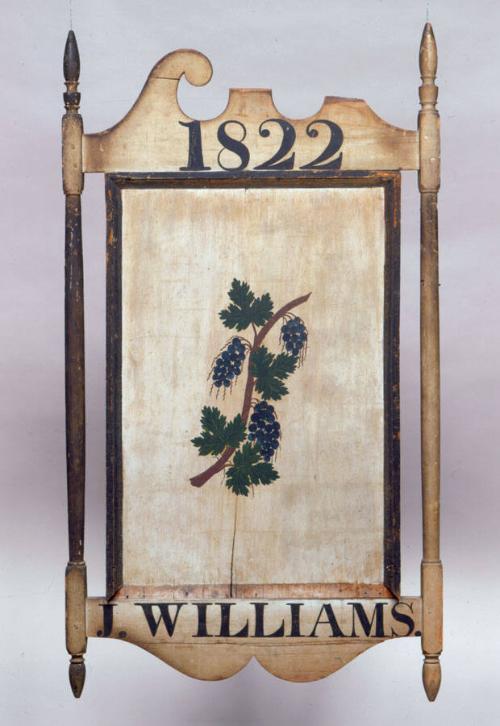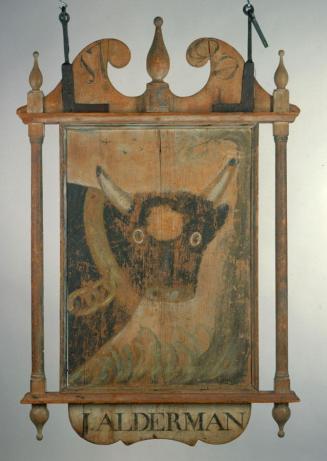Sign of the Grapes
Date1822
MediumPaint on pine
DimensionsPrimary Dimensions (height x width including hardware): 64 1/4 x 33 1/2in. (163.2 x 85.1cm)
Other (height x width of sign only): 57 1/2 x 32 7/16in. (146.1 x 82.4cm)
ClassificationsPainting
Credit LineCollection of Morgan B. Brainard, Gift of Mrs. Morgan B. Brainard
Object number1961.63.17
DescriptionImages: On both sides, a grapevine with three bunches of grapes, centered on board.
Text: On both sides, on top rail, " 1822"; on bottom rail, "J. WILLIAMS."
Construction: Single board, grain oriented vertically. Flat, horizontal rails with pediment and skirt extensions and turned, columnar posts. Board is tenoned into rails. Rails are tenoned through turned posts and doubled pinned. Rails extend vertically and are hand-sawn at top and bottom to create decorative pediment and skirt profiles. Applied molding strips are nailed to both faces of board.
Text: On both sides, on top rail, " 1822"; on bottom rail, "J. WILLIAMS."
Construction: Single board, grain oriented vertically. Flat, horizontal rails with pediment and skirt extensions and turned, columnar posts. Board is tenoned into rails. Rails are tenoned through turned posts and doubled pinned. Rails extend vertically and are hand-sawn at top and bottom to create decorative pediment and skirt profiles. Applied molding strips are nailed to both faces of board.
Collections
Label TextToo many J. Williamses exist in the records of the early 1820s to suggest any particular place of origin for this sign. Certain qualities of the sign demonstrate the maker’s familiarity with furniture-making refinements, such as the scrolled pediment, double-ogee skirt, and finials. While the image of grapes and grapevines unambiguously refers to wine-drinking, their specific configuration also recalls the grapevines on the Connecticut seal.
NotesTechnique Note: Grapes are blue, green and brown, molding and lettering are black, background is white. Evidence of blue and red paint under the white on the posts as well as the surface qualities of the grape clusters, suggest that this sign has been repainted. There is a disparity in the paint layering and wear in different areas of the sign. The lettering is of higher quality craftsmanship than the present image. Possible charring of surfaces now covered by the uppermost paint layer indicate that the sign may have been in or near a fire. The sequence of charring followed by painting is also consistent with a cleaning technique, described in 19th-century painters' manuals, which involves burning away old paint prior to repainting (see Webber, "Signs Faithfully Executed", chapter 6).Status
Not on viewCaptain Aaron Bissell Sr.
1827-1836
1772-1786













